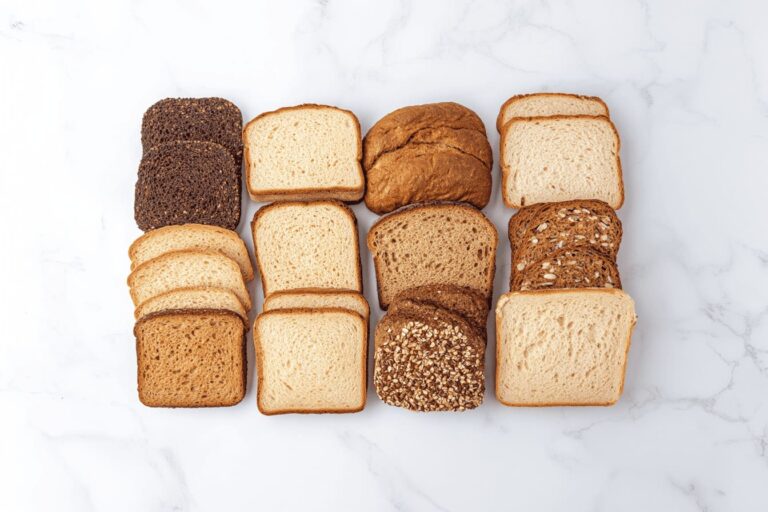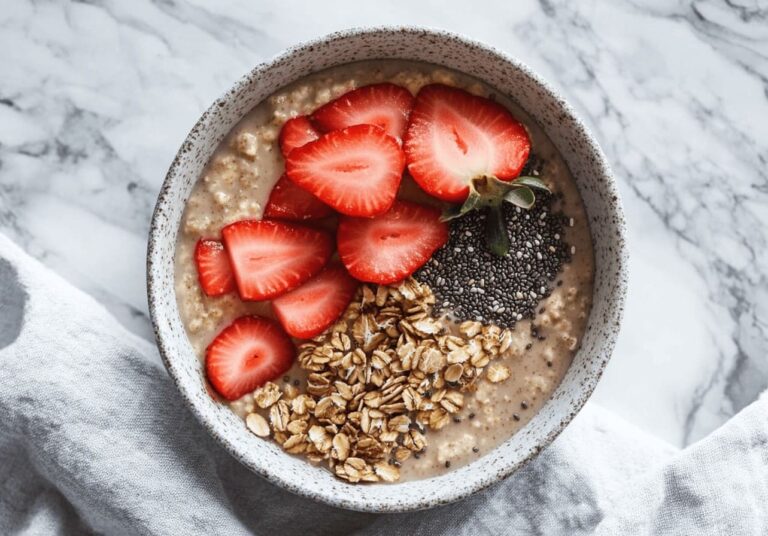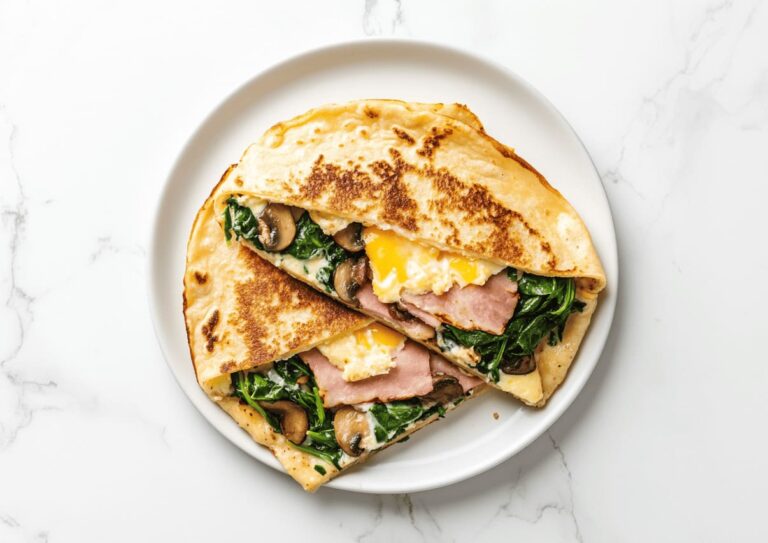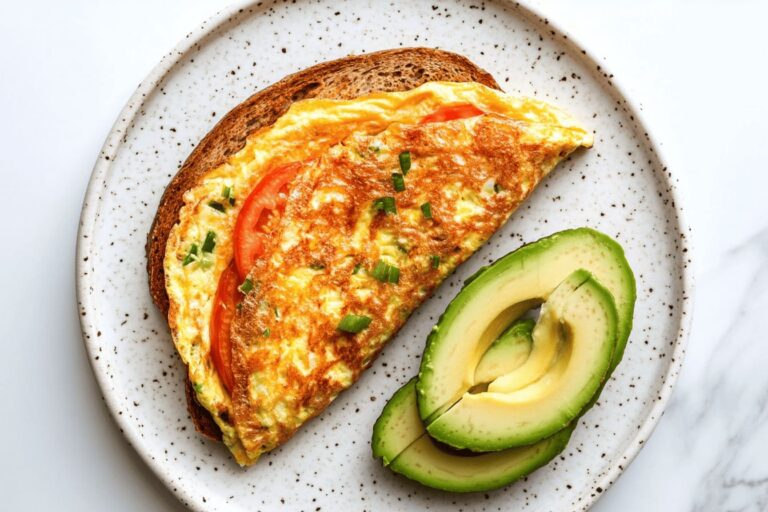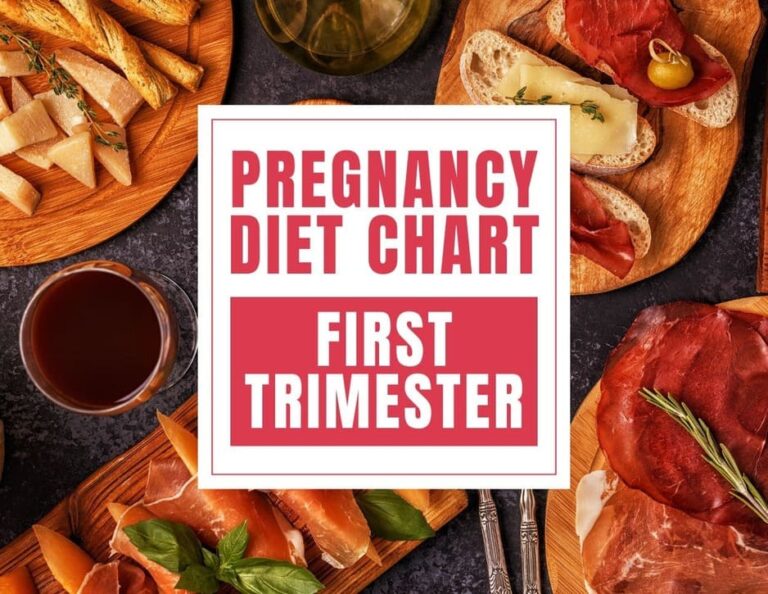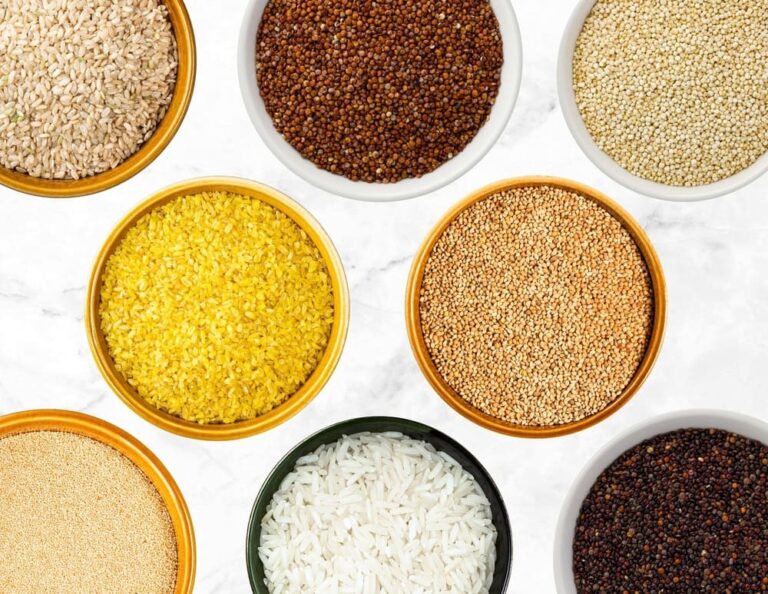16 Types of Bread With The Lowest Glycemic Index for Diabetics: Pros & Cons and Suggested Brands
This post may contain affiliate links. That means if you click and buy, I may receive a small commission (at zero cost to you). Please see my full disclosure policy for more details.
Discover the 16 best breads with the lowest glycemic index! Explore pros and cons, suggested brands, and tips on reading labels for healthier bread choices.
White bread has been a staple for so long, and I’ve been eating it for decades.
So when I was diagnosed with prediabetes, suddenly being asked to cut ties with it? That was HARD!
But here’s the silver lining: whether you’re looking to control blood sugar, lose weight, improve gut health, or simply want a healthier alternative, you don’t have to say no to bread.
There are plenty of breads with the lowest glycemic index that still give you that satisfying, soft slice without the blood sugar spike.
Let’s explore some of the best bread choices that let you enjoy your carbs while keeping your health in check!
Related: 20 Top Highest Fiber Breads from Amazon
How Does Breads with the Lowest Glycemic Index Look Like?
White bread typically has a GI of 70 or higher, which can send your blood sugar on a rollercoaster ride, spiking and crashing like a yo-yo.
Breads with the lowest glycemic index, on the other hand, is what you should be looking for:
- Whole Grain Base: Often made with whole grains like oats, rye, or spelt for better nutrition.
- Low-Moderate Carb: Contains 15-20g of carbs per slice or less to manage blood sugar.
- High Fiber: Packs at least 3g of fiber per slice, supporting digestion and fullness.
- Low GI: Has a glycemic index below 70, with lower numbers being more sugar-friendly.
You may be interested: Glycemic Index of over 650+ foods (free printable PDF included)
Reading the Label
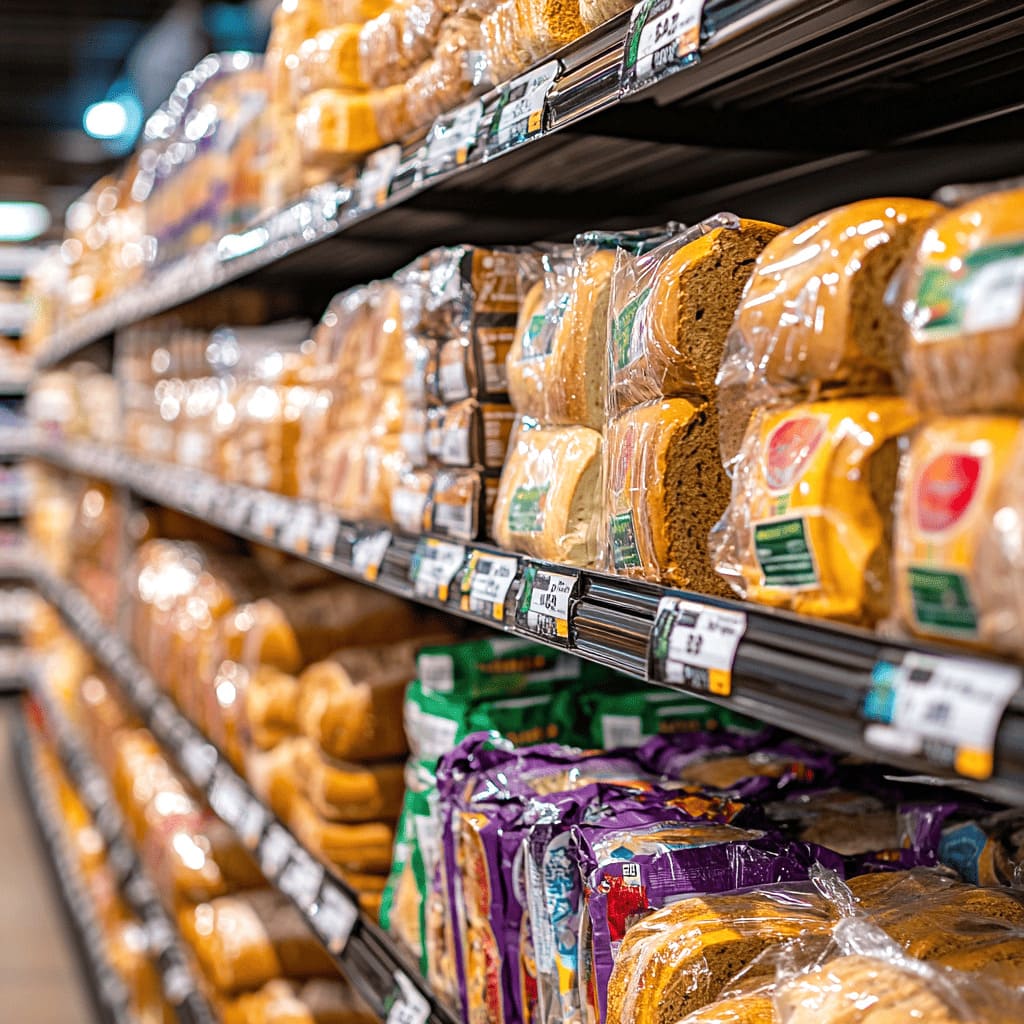
When it comes to choosing the right bread, reading the label is crucial—especially with so many marketing tricks out there!
While a loaf might look healthy on the outside, the ingredients and nutrition facts tell the real story.
Here’s what to look out for:
- Check the ingredients list:
- The first ingredient should be something like “whole wheat flour,” “whole rye,” or “whole grain.”
- If it lists refined flours (like “white flour” or “enriched flour”), put it back on the shelf.
- Look for fiber:
- Aim for at least 3g of fiber per slice.
- The more fiber, the lower the glycemic index, as fiber helps slow sugar absorption.
- Watch the carbs:
- Be mindful of the total carbs per slice. 15-20g or less per slice is ideal if you’re managing blood sugar.
- The fewer carbs, the better!
- Check for added sugars:
- Make sure there’s <5g of added sugar per slice.
- The fewer added sugars, the better—bread should not be a sugar bomb!
- Go for low sodium:
- Opt for breads with less than 300mg of sodium per slice.
- Too much sodium can raise blood pressure, so a low-sodium option is always better.
- Avoid preservatives:
- Some breads have a long shelf life because of added preservatives.
- Opt for breads with fewer artificial additives and chemicals.
- Look for whole grains:
- If the label says “multigrain,” make sure it actually contains whole grains.
- “Whole grain” or “100% whole wheat” is a much better option than just “grain.”
- Avoid refined flours:
- Stay away from white bread or breads made with refined flours, as they have a high GI and cause quick spikes in blood sugar.
All my recommendations meet these criteria with a 10% exception.
I strongly believe enjoying the bread matters as much as meeting your health goals.
That’s why there’s room for variations—like Hero Seeded White Bread, which uses resistant starch (not whole grain), and Dave’s Killer Bread, which has higher added sugar.
Bottom line: Always take a look at the label before buying, and keep an eye on your blood sugar, since everyone reacts a bit differently to different bread brands.
Disclaimer: The information in this blog post is for general purposes only and not medical advice. Always consult a healthcare professional before making any dietary changes. Individual needs may vary, and this post should not replace personalized medical guidance.
Beware of the Label Tricks!
Here are some common label tricks to watch out for:
- “Multigrain”: Doesn’t always mean whole grains—could be refined flours mixed with a little whole grain.
- “Natural” or “Organic”: Sounds healthy, but it’s often just a marketing term with no specific meaning, and it may still contain refined sugars or additives.
- “Made with whole grains”: Make sure the first ingredient is a whole grain—otherwise, it might still be mostly refined flour.
- “Low fat”: Sometimes, low-fat breads replace fat with added sugar, which could spike your blood sugar.
- “Gluten-free”: While gluten-free can be a healthy choice for some, these breads might be made with refined flours that are higher in carbs and sugar.
- “No preservatives”: While it sounds great, be careful—some of these breads might be loaded with added sugars or artificial ingredients to extend shelf life.
- “Light” or “low calorie”: Breads with the lowest glycemic index may contain extra sugar, artificial sweeteners, or refined flour to make them taste good, even though they are lower in calories.
16 Breads with the Lowest Glycemic Index
What type of bread has the lowest glycemic index?
| No | Per 2 Slices | Carb (g) | Net Carb (g) | Calorie (kcal) | Protein (g) | Fat (g) | Fiber (g) | Sugar (g) |
|---|---|---|---|---|---|---|---|---|
| 1 | White Bread | 25.3 | 24.1 | 133 | 3.82 | 1.64 | 1.2 | 2.16 |
| 2 | Whole Wheat Bread | 24.51 | 22.21 | 135 | 4.75 | 2.14 | 2.3 | 2.85 |
| 3 | Rye Bread | 30.91 | 27.21 | 166 | 5.44 | 2.11 | 3.7 | 2.46 |
| 4 | Multigrain Bread | 24.13 | 20.83 | 131 | 5.2 | 1.98 | 3.3 | 5.23 |
| 5 | Sourdough Bread | 25.95 | 24.45 | 137 | 4.4 | 1.5 | 1.5 | 0.12 |
| 6 | Mixed Grain Bread | 24.13 | 20.83 | 131 | 5.2 | 1.98 | 3.3 | 5.23 |
| 7 | Oatmeal Bread | 26.19 | 23.99 | 145 | 4.54 | 2.38 | 2.2 | 4.4 |
| 8 | White Pita Bread x1 | 33.42 | 32.12 | 165 | 5.46 | 0.72 | 1.3 | – |
| 9 | Whole Wheat Pita Bread x1 | 35.2 | 30.5 | 170 | 6.27 | 1.66 | 4.7 | 0.52 |
| 10 | Banana Bread | 65.52 | 64.22 | 391 | 5.16 | 12.6 | 1.3 | – |
| 11 | Baguette | 66.43 | 62.63 | 351 | 11.26 | 3.84 | 3.8 | 0.31 |
| 12 | Garlic Bread | 26.46 | 24.86 | 191 | 4.5 | 7.41 | 1.6 | 0.24 |
| 13 | Bread Stick x1 | 6.84 | 6.54 | 41 | 1.2 | 0.95 | 0.3 | 0.13 |
| 14 | Ciabatta | 20 | 18.9 | 108 | 3.52 | 1.4 | 1.1 | 0.33 |
Disclaimer: The nutritional values shared are estimates based on product labels and available sources. Variations may occur depending on brands and recipes. Always check packaging label for precise details.
1. Whole Grain Bread (GI = 65)
Whole grain bread—the real MVP of healthy carbs, made with flour that keeps the whole grain intact, including the bran, germ, and endosperm.
That means it’s packed with fiber (2x more), vitamins, and minerals, giving you way more nutrients than plain old white bread ever could.
Pros: High in fiber and nutrients, supports digestion and stable blood sugar, promotes heart health, provides long-lasting energy, rich in vitamins and minerals, can improve gut health
Cons: Dense texture and strong taste, not gluten-free, may cause bloating in sensitive individuals, less shelf-stable than white bread, can be more expensive, requires careful label reading to ensure quality
Popular Brands: Dave’s Killer Bread 21 Whole Grains & Seeds (Thin-Sliced), Oroweat Whole Grains 12 Grains and Seeds Bread
2. Multigrain Bread (GI = 39-68)
Multigrain bread is a mix of grains like oats, barley, and millet, giving it a unique flavor and texture.
Unlike whole grain bread, which uses the whole kernel of a single grain, multigrain isn’t always made with whole grains—so you might miss out on some fiber and nutrients unless it says “100% whole grain.“
Pros: Versatile and flavorful, can include nutrient-rich grains, supports digestion, provides steady energy, great for variety in your diet
Cons: Not always whole grain, may contain added sugars, less fiber-rich than whole grain bread, often pricier
Popular Brands: Oroweat Whole Grains Healthy Multi-Grain Bread, Nature’s Own Perfectly Crafted Multigrain Bread, Schmidt Old Tyme 647 Multigrain Bread
3. 100% Whole Wheat Bread (GI = 51-69)
100% whole wheat bread is made from the entire wheat kernel—bran, germ, and endosperm.
Here’s the catch: don’t be fooled by labels! Some sneaky manufacturers try to trick you with just 10% whole wheat flour and the rest refined flour.
Make sure it’s truly 100% whole wheat (just follow my suggested brands)!
Pros: High in fiber and nutrients, supports digestion, wider variety to suit different preferences, promotes heart health, provides long-lasting energy, can improve gut health
Cons: Dense texture, may have a stronger taste, not gluten-free, can be more expensive, may cause bloating for sensitive people, may need thinner slices to prevent sugar spike
Popular Brands: Nature’s Own 100% Whole Wheat Bread
4. Sourdough Bread (GI = 54)
Sourdough bread is all about that tangy flavor, thanks to natural fermentation with wild yeast.
It’s not just tasty, it’s easier to digest than regular bread, and the fermentation process even helps lower its glycemic index.
Plus, it’s often made with whole grains for an extra nutrient boost!
Pros: Naturally fermented for easier digestion, lower glycemic index, unique flavor, may help with blood sugar, less processed, may have probiotics for gut health
Cons: Not gluten-free, can be dense, not always high in fiber, can be pricey, may be too tangy for some, requires a longer baking time or special starter
Popular Brands: Base Culture Sourdough Bread
5. Sprouted Bread / Ezekiel Bread(GI = 36)
Sprouted bread is made from grains that have been soaked and allowed to sprout, which boosts its nutrient profile and makes it easier to digest.
This process breaks down some of the starches and makes it a lower-GI option.
Plus, it’s often packed with fiber, vitamins, and minerals.
Pros: Easier to digest, lower glycemic index, high in fiber and nutrients, supports digestion, may improve blood sugar control
Cons: Not gluten-free, can be dense, more expensive, may be harder to find
Popular Brands: Food For Life Flourless Sprouted Grain Bread
6. Rye Bread (GI = 65)
Rye bread is made with rye flour, which comes from a different grain than wheat.
It has a denser texture and a slightly sour flavor, and its natural properties give it a lower glycemic index than regular wheat bread.
If you’re looking for an even more sugar-friendly option, go for whole rye (like my suggested brands below), which packs in more fiber and nutrients compared to white rye or wheat breads.
Pros: Lower glycemic index, high in fiber, supports digestion, helps control blood sugar, richer in nutrients than white bread
Cons: Not gluten-free, denser texture, can be an acquired taste, may cause bloating for some, often pricier
Popular Brands: Mestemacher Bread Whole Rye Bread (note: high carb at 26g per piece), Bavarian Bread Organic Whole Rye Bread
7. Pumpernickel Bread (GI = 45)
Both pumpernickel and rye breads are made with rye, but pumpernickel goes all out—it’s darker, denser, and baked low and slow for that rich, earthy flavor and extra nutrients.
With 1.7g of fiber per slice (compared to rye’s 1.5g) and a lower glycemic index, traditional pumpernickel, often made with whole rye, is the more sugar-friendly choice!
Pros: Low glycemic index, high in fiber, supports digestion, rich in nutrients, great for blood sugar control, distinct hearty flavor
Cons: Not gluten-free, very dense texture, may be too strong for some tastes, harder to find, can cause bloating for sensitive stomachs
Popular Brands: Mestemacher Bread Pumpernickel Bread
Pumpernickel vs Rye Bread
It depends on what you’re looking for!
Pumpernickel bread has a lower glycemic index than standard rye bread, making it the better choice if you’re focusing on blood sugar control. It’s also denser, heartier, and often made with whole rye, giving it more fiber and nutrients.
Rye bread, on the other hand, is less dense and has a milder flavor, which might be easier to enjoy for those new to rye-based breads. If it’s made with whole rye, it’s still a great option for digestion and stable blood sugar.
If blood sugar control and fiber are your priorities, pumpernickel edges out as the winner. For a lighter, more versatile option, rye bread might be the way to go!
8. Low-Carb White Bread (GI = 20-65)
If you’ve been loyal to white bread for decades and can’t quite cut ties, here’s the good news—keto-friendly low-carb white bread exists!
Made with ingredients like water, resistant starch, wheat protein isolate, almond flour, and more, it skips the starches and swaps in protein and fiber to keep things sugar-friendly.
Pros: Low in carbs, helps with blood sugar control, soft texture similar to regular white bread, often high in protein and fiber, great for keto or low-carb diets
Cons: Not whole grain, fewer natural nutrients, can be pricier, sometimes has added fillers or preservatives, taste and texture can vary between brands
Popular Brands: Hero Bread™ Classic White Bread, Nature’s Own Life Keto Soft White Bread, Low Carb Avenue – Artisan Keto Bread
9. Grain-Free Bread (GI = depends on ingredients)
Grain-free bread is perfect for those skipping grains altogether.
Made with alternatives like almond flour, coconut flour, cassava or even cauliflower, it’s naturally gluten-free and often lower in carbs.
It’s a favorite for paleo and keto fans, offering a healthy twist on your classic loaf.
Pros: Grain-free and gluten-free, often lower in carbs, packed with healthy fats and protein, great for paleo or keto diets, nutrient-dense
Cons: Different texture vs the usual white loaf, not as fluffy as traditional bread, can be expensive, may have a strong nutty flavor, less fiber if not fortified with seeds or flax
Popular Brands: Outer Aisle Gourmet Cauliflower Sampler Pack, Base Culture Keto Bread, Yez! Artisan Keto Bread
10. Buckwheat Bread (GI = 50)
Buckwheat bread might sound like it’s related to wheat, but surprise—it’s not!
Buckwheat is actually a gluten-free seed, making this bread a fantastic option for those with gluten sensitivities.
It’s hearty, nutrient-dense, and packed with fiber and antioxidants, perfect for anyone looking to switch things up from regular bread.
Pros: Can be gluten-free, high in fiber, rich in antioxidants, supports digestion, low glycemic index for better blood sugar control
Cons: Denser texture, earthy flavor that may not suit everyone, can be pricier than regular bread, less fluffy than wheat-based options
Popular Brands: Le Pain des Fleurs Crispbread, Pacha Buckwheat Bread
11. Spelt Bread (GI = 61)
Spelt bread brings an ancient grain twist to your loaf game.
Made from spelt flour, it’s nuttier and slightly sweeter than regular wheat bread, with a lighter texture than whole wheat.
While spelt is easier to digest for some, it still contains gluten, so it’s not suitable for everyone.
Pros: High in fiber and nutrients, nutty flavor with a light texture, easier to digest than modern wheat for some, great source of protein and minerals
Cons: Not gluten-free, less shelf-stable, may cause bloating for sensitive stomachs, pricier than regular wheat bread
Popular Brands: Berlin Natural Bakery Sourdough Spelt Bread
12. Oat Bread (GI = 65)
Made with oat flour or rolled oats, it’s packed with fiber, especially beta-glucan, which helps lower cholesterol and keep you full longer.
Soft and slightly sweet, it’s a heart-healthy option that works for most diets.
Pros: High in soluble fiber, supports heart health and digestion, helps with blood sugar and cholesterol control, naturally sweet and soft, rich in nutrients like iron and magnesium
Cons: Not gluten-free unless made with certified gluten-free oats, can be denser than traditional bread, less shelf-stable, sometimes mixed with refined flours
Popular Brands: The Cheesecake Factory Sweet Wheat & Oat Sandwich Loaf, Oroweat Oatnut Bread
13. Almond Flour Bread (GI = 20-40)
Almond flour bread is the low-carb hero of the bread world, made with almond flour, which has a glycemic index of 0.
It can be gluten-free, grain-free, and loaded with healthy fats and protein.
With its nutty flavor and moist texture, it’s a favorite for keto and paleo diets.
Pros: With gluten-free and grain-free option, extremely low glycemic index, high in healthy fats and protein, helps with blood sugar stability, nutrient-dense with vitamin E and magnesium
Cons: Dense texture, pricier than traditional bread, nutty flavor may not suit everyone, fewer carbs but less fiber unless mixed with flax or psyllium
Popular Brands: Dr. B’s Multigrain Bread, Yez! Artisan Golden Flax Keto Bread, Maria & Ricardo’s KETO Tortillas
14. Flaxseed Bread (GI = 35-51)
Made with ground flaxseeds, this bread is a nutritional superstar rich in omega-3 fatty acids, fiber, and antioxidants.
Its earthy, nutty flavor makes it a satisfying, health-conscious choice.
Pros: High in omega-3s, excellent source of fiber, supports heart health and digestion, low glycemic index, rich in antioxidants and lignans, gluten-free when made without wheat, aids in weight management, promotes healthy skin and hormonal balance
Cons: Can be dense compared to traditional bread, may require refrigeration to maintain freshness, flavor might be too earthy for some, often more expensive than regular bread, less widely available in stores
Popular Brands: Shibolim FlaxSeed Bread
15. Tortillas (GI = 30)
Prefer something else other than the boring sandwich loaf?
Tortillas are a classic, versatile flatbread that can be made from a variety of flours—wheat, corn, or even grain-free options like almond flour.
Whether you’re wrapping up a burrito or making tacos, tortillas are quick, easy, and delicious.
Pros: Quick and easy to make or buy, versatile for various fillings, can be made gluten-free or low-carb, soft texture, convenient for wraps, tacos, and quesadillas
Cons: Traditional wheat tortillas can be high in carbs, many store-bought options are processed, can be low in fiber unless using whole grains, may not fit keto or low-carb diets unless specifically made
Popular Brands: Mr. Tortilla Low Carb Keto Soft Taco Shells, Mission Carb Balance Soft Taco Whole Wheat Tortillas
16. Pita Bread (GI = 57)
Pita bread is a soft, round flatbread with a pocket in the middle, making it perfect for stuffing with all your favorite fillings.
Made from simple ingredients like flour, water, and yeast, it’s a versatile choice for sandwiches or wraps.
Pros: Soft and fluffy with a unique pocket for fillings, versatile for sandwiches, wraps, and dips, quick and easy to prepare, available in whole grain options for added fiber
Cons: Can be high in carbs, traditional pita made with white flour has lower fiber, not gluten-free, some store-bought options can be processed with additives
Popular Brands: Papa Pita Greek Whole Wheat Pita, Joseph’s Low Carb Mini Pita Bread
Related: 20 Top Highest Fiber Breads from Amazon
Here’s the Thing!
What works for one person might not work for another!
Maybe whole grain bread keeps your sugar steady, or maybe sourdough is your secret weapon.
Always, and I mean always, check your blood sugar after trying a new bread. You might be totally surprised!
Once you find your perfect match, stick with it and enjoy your bread-loving life guilt-free.
How to Enjoy Breads with the Lowest Glycemic Index
Now that you finally know the right breads with the lowest glycemic index, that’s only half of the story.
But did you know there’s more you can do to prevent sugar spikes while still enjoying bread?
Small tweaks to your portion sizes, food pairings, and meal timing can make a big difference in how your body processes carbs:
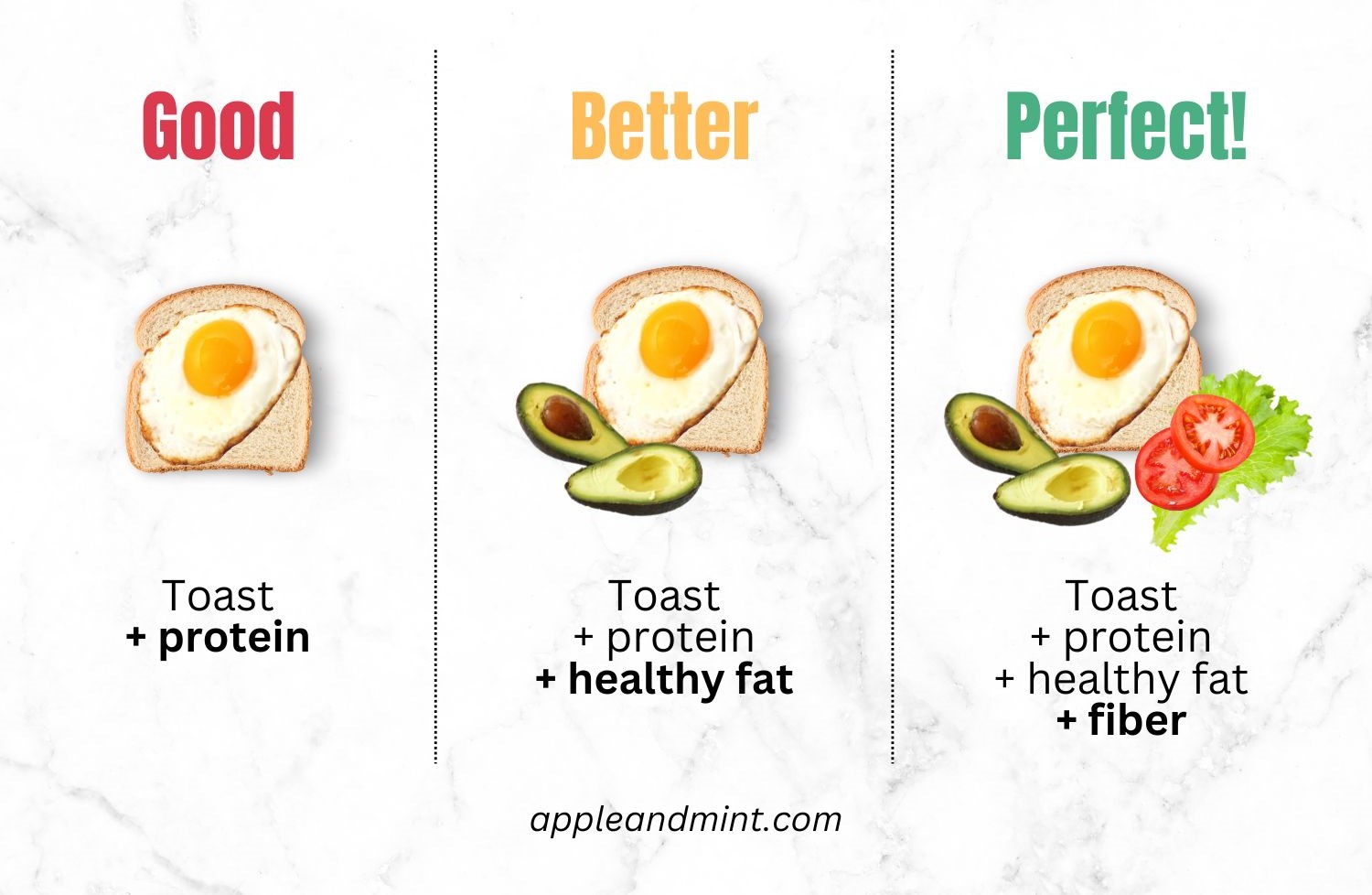
- Control Portion Sizes:
- Stick to 1-2 slices per meal.
- Look for bread with around 15-20g or fewer carbs per slice to avoid overloading on carbs.
- Pair with Protein:
- Combine bread with a source of protein like eggs, chicken, turkey, or plant-based proteins.
- This slows down the absorption of carbs and helps stabilize blood sugar levels.
- Add Healthy Fats:
- Incorporate Fiber:
- The more fiber, the better! Choose bread that’s high in fiber (at least 3g per slice) or add fiber-rich toppings like veggies, chia seeds, or flaxseeds.
- Fiber helps with digestion and keeps blood sugar from spiking.
- Consider Freezing Bread:
- If you find yourself tempted to overeat bread, try freezing slices and thawing them as needed. This way, you can control portions and keep it fresh longer.
- Toast It!:
- Try lightly toasting your bread.
- The toasting process can slightly lower the glycemic index of some breads, meaning it may have a gentler effect on your blood sugar.
- Use Bread as a Side:
- Instead of making bread the main component of your meal, try using it as a side.
- This will help you control portion sizes and balance your meal with other nutritious foods.
- Balance Your Carbs throughout the Day:
- If you enjoy bread for one meal, make sure the other meals are lower in carbs.
- This helps spread your carb intake evenly throughout the day, reducing the risk of blood sugar spikes.
Frequently-Asked Questions
How many slices of bread can a diabetic eat per day?
Stick to 1-2 slices of bread per day and aim for bread that contains 15-20g carbs or less per slice. Pair your bread with fiber, protein, and healthy fats to balance out the carbs and prevent spikes in blood sugar.
Does toasting bread make it better for diabetics?
Toasting bread slightly lowers its glycemic index. The toasting process causes the starches to change structure, which can reduce the bread’s impact on blood sugar. However, it’s not a huge difference—choosing whole grain, sourdough, or other low-GI bread is more important for blood sugar management.
Does frozen bread have a lower glycemic index?
Freezing bread doesn’t significantly alter its glycemic index. The glycemic index depends more on the ingredients and how the bread is made. If the bread is made with refined flour or high sugar content, freezing it won’t make it a better option for diabetics.
White breads with lowest glycemic index?
There are many keto white bread options available (like Hero Classic White Bread) that are made with low-carb ingredients like almond flour or resistant starch. Just be sure to check the label for carb content and additives.
Final Thoughts
Choosing the right breads with the lowest glycemic index doesn’t have to be a challenge when managing your blood sugar.
By opting for low-GI breads, paying attention to labels, and pairing your bread with the right balance of fiber, protein, and healthy fats, you can enjoy bread without the worry of sugar spikes.
It’s all about making smart choices that fit your lifestyle and needs. So go ahead, enjoy your favorite slice of bread—just make sure it’s the right one for you!

















